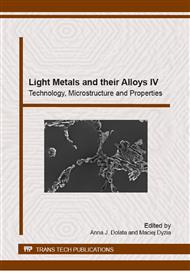p.71
p.77
p.83
p.89
p.99
p.105
p.115
p.125
p.131
Stability of the Structure of WE43 Cast Magnesium Alloy Welded Joints at Elevated Temperatures
Abstract:
The WE43 cast magnesium alloy is characterized by high development prospects due to its strength properties and maximum operating temperature of up to 250°C. It is used in the automotive and aircraft industries for engine, hull and gear parts. These are mainly individual or low-volume large-size casts, which in the casting process may display some defects in the form of misruns, shrinkage porosities and cracks. These defects are repaired with the application of welding technologies, which are also used to joint castings into structures and to repair castings after operation. The weld joint is an integral part of the structure. Therefore, it decides on the properties of the entire structure. It is important to get to know the microstructure and properties of magnesium alloy weld joints, and in particular those of the fusion weld. In this paper stability of the structure of WE43 cast magnesium alloy welded joint was researched.
Info:
Periodical:
Pages:
105-114
Citation:
Online since:
April 2015
Authors:
Price:
Сopyright:
© 2015 Trans Tech Publications Ltd. All Rights Reserved
Share:
Citation:


